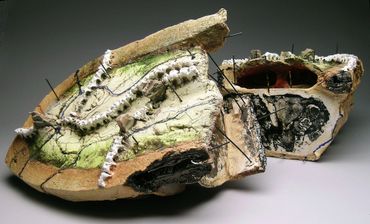Artist Statement
My work has always been concerned with the passage of time and the way that a form or landscape endures and records experience. Humans are affected and imprinted by time; are set at the center of it and made insignificant by it; cultures intentionally keep track of it and can never control it. I am interested in the way that history forms strata of different types of documentation: both as part of a natural process and an intentional record. My work embraces the constant change of the past and suggests the future evolution
Fairytales Revisited Series
An Interview with Featured Artist Dana Kroos
Published in Gambling the Aisle, Spring 2011,
Dana Kroos is a writer and artist who lives in New Mexico. She has taught ceramics and currently teaches a variety of writing classes at New Mexico State University in Las Cruces. Her work has appeared in exhibitions across the United States.
John Cross: Tell me about the “Fairy Tales Revisited” series.
Dana Kroos: Fairy tales fit into the realm of teaching stories, along with myths, folklore, legends and others. These stories were designed not primarily to entertain, but to explain and instruct. They not only offer reasons for why night and day exist, life and death, mountains, rivers, and trees, but also talk about human emotions, behaviors and situations.
These stories teach lessons. They tell us how to live and reinforce social structures. But in contemporary times we have come to questions or even disagree with some of the lessons that they teach and the harsh way in which they teach them. Fairy tales are unique because they are traditionally stories written for children. The Brothers Grimm, who are responsible for many of the fairytales that we still tell children today, first published a collection of stories in 1812, but some of the included stories were adapted from versions dating back to the 1600s.
As someone who grew up in the seventies, I can tell you that the way our culture believes children should be treated and taught has changed significantly in just forty years (in the seventies and eighties, not only would my parents never have thought of asking me to wear a bike helmet, but our car didn’t even have seat belts installed and the local theater let in every customer—1 to 100—with total disregard for the loose rating system that was in place).
From a modern perspective, not only do these fairy tales put their children characters in jeopardy, but they seem to put our actual children in jeopardy through exposure to the stories. Disney has softened and watered down the original tales into adaptations that parents of the twenty-first century are comfortable with, but the original Grimm stories contain tales of parents murdering and attempting to murder their children, kidnapping, and elder and child abuse. These stories end “happily,” that is to say, the protagonists survive and triumph over their enemies, but often at the cost of having to commit heinous acts themselves, or at least having undergone significant trauma.
I am interested in the way that fairy tales take (what I would consider to be) adult content, and cater it for children. Of course, the Brothers Grimm are not solely responsible for this. Mother Goose is also packed with nursery rhymes and children’s poems which sound innocent on the surface but are in fact about more serious matters. “Ring-a-Ring o’ Roses” is a common one, a nursery rhyme—still heard today—about victims of the plague. “Peter Peter Pumpkin Eater” also disturbs me—the story of a man who imprisons his wife and “there he kept her very well.”
The “Fairy Tales Revisited” series is comprised of sculptures and collages that include imagery and passages from fairy tales, in combination with historical imagery and factual information. As sculptural forms, they represent adaptations of characters or symbols from fairy tales or mythology; as collages, they depict a character or scene that takes the form of a page in a picture book. This work explores the possible adult content present in some of these stories written for children and questions the lessons that are being taught through these stories by putting them into the context of history and real life.
Wide Net



Ceramic Work
I use clay and other media to create forms that have a presence in the moment and their contemporary environments, but which also suggest this history. My creamic forms are built through a process of construction and deconstruction borrowing parts from other works, attaching molded objects and layering information on the surface. This synthesis reveals the development of the form to fully explore the nature and chronicle of the work.
This body of work explores the relationship between architectural and corporeal structure. It plays with industrial and skeletal structure combining the two to suggest the ways in which they mirror and contrast one another. This work strives to put the human figure into industrial terms and to give humanity to the manufactured construction. This has been done both through form and through a mapping system on the surface that works to decipher the physics and gestures of the forms.
Figurative
Shipwreck Series








Carved Story Urns
How to Do Everything Right Dinner Conversation Installation
How to Understand Acoustics
Assembled Vessels
Cecil Rhodes Stacking Tea Sets for Travel
LARGE SCALE WORK
This website uses cookies.
We use cookies to analyze website traffic and optimize your website experience. By accepting our use of cookies, your data will be aggregated with all other user data.


















